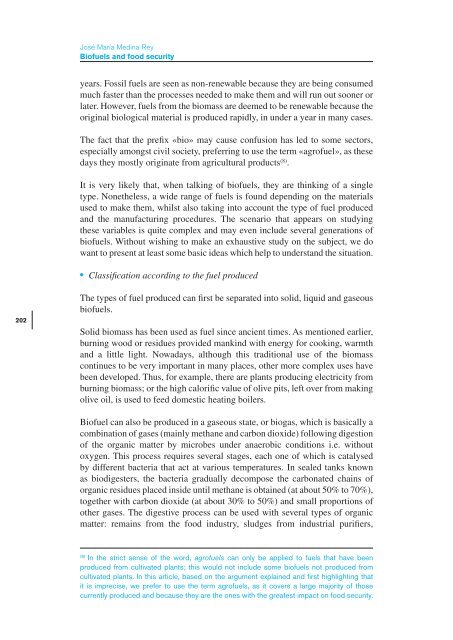Food security and global security - IEEE
Food security and global security - IEEE
Food security and global security - IEEE
- No tags were found...
You also want an ePaper? Increase the reach of your titles
YUMPU automatically turns print PDFs into web optimized ePapers that Google loves.
José María Medina ReyBiofuels <strong>and</strong> food <strong>security</strong>years. Fossil fuels are seen as non-renewable because they are being consumedmuch faster than the processes needed to make them <strong>and</strong> will run out sooner orlater. However, fuels from the biomass are deemed to be renewable because theoriginal biological material is produced rapidly, in under a year in many cases.The fact that the prefix «bio» may cause confusion has led to some sectors,especially amongst civil society, preferring to use the term «agrofuel», as thesedays they mostly originate from agricultural products (8) .It is very likely that, when talking of biofuels, they are thinking of a singletype. Nonetheless, a wide range of fuels is found depending on the materialsused to make them, whilst also taking into account the type of fuel produced<strong>and</strong> the manufacturing procedures. The scenario that appears on studyingthese variables is quite complex <strong>and</strong> may even include several generations ofbiofuels. Without wishing to make an exhaustive study on the subject, we dowant to present at least some basic ideas which help to underst<strong>and</strong> the situation.• Classification according to the fuel produced202The types of fuel produced can first be separated into solid, liquid <strong>and</strong> gaseousbiofuels.Solid biomass has been used as fuel since ancient times. As mentioned earlier,burning wood or residues provided mankind with energy for cooking, warmth<strong>and</strong> a little light. Nowadays, although this traditional use of the biomasscontinues to be very important in many places, other more complex uses havebeen developed. Thus, for example, there are plants producing electricity fromburning biomass; or the high calorific value of olive pits, left over from makingolive oil, is used to feed domestic heating boilers.Biofuel can also be produced in a gaseous state, or biogas, which is basically acombination of gases (mainly methane <strong>and</strong> carbon dioxide) following digestionof the organic matter by microbes under anaerobic conditions i.e. withoutoxygen. This process requires several stages, each one of which is catalysedby different bacteria that act at various temperatures. In sealed tanks knownas biodigesters, the bacteria gradually decompose the carbonated chains oforganic residues placed inside until methane is obtained (at about 50% to 70%),together with carbon dioxide (at about 30% to 50%) <strong>and</strong> small proportions ofother gases. The digestive process can be used with several types of organicmatter: remains from the food industry, sludges from industrial purifiers,(8)In the strict sense of the word, agrofuels can only be applied to fuels that have beenproduced from cultivated plants; this would not include some biofuels not produced fromcultivated plants. In this article, based on the argument explained <strong>and</strong> first highlighting thatit is imprecise, we prefer to use the term agrofuels, as it covers a large majority of thosecurrently produced <strong>and</strong> because they are the ones with the greatest impact on food <strong>security</strong>.
















